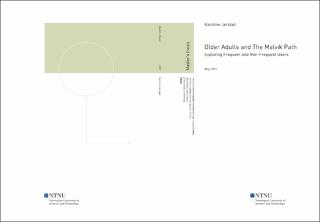| dc.contributor.advisor | Maass, Ruca Elisa Katrin | |
| dc.contributor.author | Jørstad, Karoline | |
| dc.date.accessioned | 2021-09-25T16:28:55Z | |
| dc.date.available | 2021-09-25T16:28:55Z | |
| dc.date.issued | 2021 | |
| dc.identifier | no.ntnu:inspera:82525395:14551758 | |
| dc.identifier.uri | https://hdl.handle.net/11250/2783168 | |
| dc.description.abstract | Bakgrunn: Den eldre populasjonen vil vokse, og med økende alder kommer inaktivitet og dårligere helse. Teorien om occupation understrekete viktigheten av det sammenhengende forholdet mellom person, helse, aktivitet og omgivelser: og helse promotering er en strategi for å tilnærme seg dette. I litteraturen kan man se noe bevis for sammenhengen mellom omgivelser, aktivitet of helse.
Aim: Målet med denne oppgaven er å utforske hyppige og ikke-hyppige brukere av Malvikstien, og se på personlige og omgivelsesmessige faktorer, og fysisk aktivitet, for å (i) se om omgivelsesmessige faktorer kan føre til bruk av stien, og (ii) om noen kan forklare hvordan bruk av stien kan promotere helse.
Method: Data brukt kommer fra et data register på innbyggerne i Malvik, og statistiske analysere blir gjennomført. Analysene omfattet deskriptive-, komparative og korrelasjons analyser, og ble gjennomført på hyppige og ikke-hyppige brukere og et sett med inkluderte variabler som dekker personlige og omgivelsesmessige faktorer, of fysisk aktivitet.
Resultat: innbyggerne i Malvik opplever at stien har god tilgjengelighet og kvalitet, of de har høye nivåer av sosial kapital of sosial interaksjon. Hyppige- og ikke-hyppige brukere hadde signifikante korrelasjoner med tilgjengeliggjort, kvalitet, sosial kapital, sosial interaksjon, og varighet av fysisk aktivitet. Ingen personlige faktorer hadde sammenheng med hyppige og ikke-hyppige brukere.
Diskusjon: Resultatene stemmer overens med tidligere forskning, occupational teori og helse promotering. Resultatene indikerer at ved å implementere grønt områder, slik som Malvikstien, så kan man promotere helse ved å skape muligheter for både fysisk og sosiale aktiviteter. | |
| dc.description.abstract | Background: The elderly population is set to grow, and whit increasing age comes higher levels of inactivity and poor health. The theory of occupation highlights the interrelationship between person, health, activity and environment: and health promotion is a strategy to approach this. In literature there are some evidence for the associations between environment and physical activity and health.
Aim: The aim of this thesis is to explore frequent and non-frequent users of the Malvik path who are 67 years and older, and look for personal-, contextual factors and physical activity, to explore (i) if any contextual factors can contribute to use of path, and (ii) if any can explain how use of path can promote health.
Method: The data used stems from a data register on residents in Malvik, and statistical analysis was conducted. The analysis consisted of descriptive-, comparative- and correlational analysis, and were performed on frequent and non-frequent users, and a set of included variables covering personal-, contextual factors and physical activity.
Result: Residents perceive the Malvik path as having good availability and quality, and they perceive high levels of social capital and social interaction. Frequent and non-frequent user of the path have significant correlations with availability, quality, social capital, social interaction and duration of physical activity. No personal factors are associated with frequent and non-frequent users.
Discussion: Results are in correlation with previous literature, and the occupational theory and health promotion approach. Results indicate that by implementing green spaces such as the Malvik path in environments, it can promote health by creating opportunities for both physical and social activities. | |
| dc.language | eng | |
| dc.publisher | NTNU | |
| dc.title | Older Adults and The Malvik Path: Exploring Frequent and Non-Frequent Users | |
| dc.type | Master thesis | |
